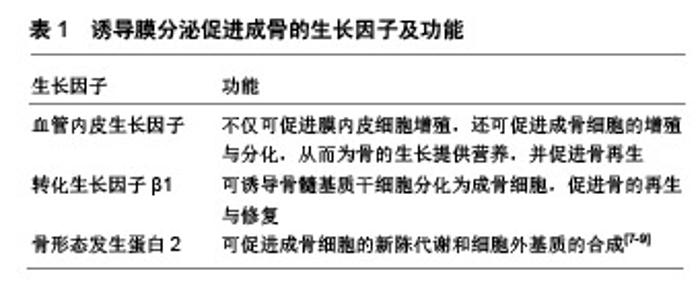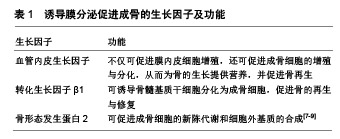Chinese Journal of Tissue Engineering Research ›› 2019, Vol. 23 ›› Issue (30): 4855-4860.doi: 10.3969/j.issn.2095-4344.1427
Previous Articles Next Articles
Induced membrane technique for repair of bone defect: research status and modification of application methods
- Department of Orthopedics, the Ninth People’s Hospital of Wuxi 214062, Jiangsu Province, China
-
Received:2019-04-27Online:2019-10-28Published:2019-10-28 -
Contact:Yi Qudong, MD, Chief physician, Department of Orthopedics, the Ninth People’s Hospital of Wuxi 214062, Jiangsu Province, China -
About author:Li Haifeng, Master, Associate chief physician, Department of Orthopedics, the Ninth People’s Hospital of Wuxi 214062, Jiangsu Province, China
CLC Number:
Cite this article
Li Haifeng, Gu Sanjun, Rui Yongjun, Yi Qudong . Induced membrane technique for repair of bone defect: research status and modification of application methods[J]. Chinese Journal of Tissue Engineering Research, 2019, 23(30): 4855-4860.
share this article

2.1 诱导膜技术的治疗机制 诱导膜是聚甲基丙烯酸甲酯(PMMA)骨水泥填塞后异物刺激反应的产物,分为2层,内层为滑膜样上皮细胞层、较薄,外层为成纤维细胞层、较厚。诱导膜的厚度与填塞部位和填塞时间有关,有1.0-2.0 mm,不同厚度主要在于外层纤维层厚度不同。诱导膜技术治疗骨缺损具有二大优势,一是骨缺损修复效果优异,二是骨感染控制良好,均与诱导膜的生物和物理特性有关。 2.1.1 骨缺损修复 诱导膜富含微血管、细胞和成骨因子,共同构成其独特的生物性成骨活性。此外,诱导膜还使骨祖细胞及其相关因子得以富集保留,起到成骨支架作用。研究显示,诱导膜上有垂直于骨长轴方向密集排列的小血管系统;在酶解后通过流式细胞术测定,每克诱导膜组织中的活细胞数是正常骨膜中的11倍,包括大量淋巴细胞、间充质干细胞、破骨细胞及破骨前驱细胞等[7]。诱导膜还能分泌多种促进成骨的生长因子,见表1。 Klaue等[6]采用犬股骨模拟骨缺损比较诱导膜和其他方法对骨缺损的修复效果,单纯内固定加游离植骨组见新骨形成,但钢板侧见应力遮挡引起部分性骨吸收,内固定加单纯诱导膜没有植骨组见稀疏的骨形成,没有骨吸收现象发生,内固定加诱导膜内植骨组的成骨最好,见丰富骨形成,单纯内固定组(对照组)缺损端见骨吸收。结果提示,诱导膜不仅避免断端骨吸收,而且可以促进诱导膜内骨形成。诱导膜的生物成骨活性与植骨时机关系密切,其次与填塞物种类和填塞部位也有一定关系。Plissier等[8]和Viateau等[9]分别进行动物实验研究诱导膜的结构和性能,结果显示,诱导膜的成生物骨活性在骨水泥填塞后4周达到高峰, 6周后逐渐下降,12周后生物成骨活性微弱。Henrich等[10]利用鼠股骨模拟骨缺损行诱导膜技术治疗,在骨水泥填塞后2-4周,诱导膜的厚度、骨形态发生蛋白2和转化生长因子β含量、血管化和细胞增殖能力均达高峰,结果也提示骨水泥填塞后2-4周内的成骨能力和血管化能力最强。然而,过早植骨的话,形成的诱导膜较薄,其包裹植骨材料作用较差,所以临床通常在骨水泥填塞后6-8周行诱导膜内植骨[1,4]。然而,对于感染性骨缺损,感染必须得到有效控制情况下行诱导膜内植骨。骨感染扩创术后通常需要抗感染治疗6周,而且主张抗生素停止后每2周复查血沉、血象或C-反应蛋白,3次以上化验结果均正常才认为感染得到控制和行第2阶段植骨[2-3,5,11]。因此,多数学者报道在负载抗生素骨水泥填塞12周后才行第2阶段植骨[2,5,11-12]。此时,诱导膜成骨活性很弱。临床应用中,还存在填塞物取出困难导致诱导膜损伤不完整,以及万古霉素浓度较高影响诱导膜的生物成骨活性等情况[12]。鉴于晚期阶段形成的诱导膜的骨诱导能力有限,为了增加其生物成骨活性,有学者提出使用骨诱导因子和骨源细胞,如骨形态发生蛋白2、间充质干细胞等,增加诱导膜囊腔内的骨生成因子和骨源细胞[1,8,10],促进骨诱导和骨形成,但是骨生长因子的最佳剂量、释放方法和骨源细胞如何使用,仍需要进一步研究,目前这种方法尚处初步实验研究阶段,组织工程技术有望解决这些问题[3]。尽管动物实验显示骨水泥填塞4周左右诱导膜成骨活性最佳[10],然而目前尚缺乏骨水泥填塞4周左右植骨效果是否优于晚期植骨者的临床应用报道。 以往研究多注重诱导膜生物活性,忽视诱导膜的机械性包裹作用。有学者认为,对于骨水泥填塞12周后行诱导膜内植骨,其修复骨缺损的主要机制在于诱导膜的机械性隔离、包裹和支架作用[5]。殷渠东等[5]报道应用钛网、线网、线捆绑皮质骨块和晚期阶段形成的诱导膜等方法包裹植骨治疗节段性骨缺损,4种包裹方法的骨愈合时间和邻近关节功能优良率比较,差异无统计学意义(P > 0.05),提示晚期阶段植骨者诱导膜生物活性较弱,诱导膜的机械性包裹作用才是修复骨缺损的主要机制所在。晚期阶段诱导膜、钛网、线网、线捆绑皮质骨块、筋膜和人工膜等方法均可以治疗大段骨缺损,它们被统称为包裹植骨方法[5]。包裹植骨方法的治疗机制在于包裹装置对植骨材料具有稳定作用,避免了颗粒状植骨材料容易散开和松动,同时植骨量通常较多,从而避免了骨吸收现象。而且,包裹植骨术后可以早期康复活动,而早期康复活动有利于刺激骨折端的骨愈合和关节功能恢复。包裹植骨治疗效果主要与植骨材料稳定性、周围血供和植骨质量有关。为了更好地发挥其机械性包裹植骨效果,在发生诱导膜损伤性缺损病例中,需要利用肌膜或筋膜等替代包裹植骨材料[3,5]。 诱导膜的生物成骨活性和机械性包裹作用均是修复骨缺损的机制所在。鉴于在不同时机植骨诱导膜的生物成骨活性相差较大,而具有单纯机械性包裹作用的包裹植骨也能修复骨缺损,因此,到底是诱导膜的生物成骨活性或是机械性包裹作用对骨缺损修复的作用更大,仍有不同意见。 除诱导膜成骨活性可能影响成骨效果外,植骨材料的大小、质量和数量也影响成骨效果。研究发现,小于1.0-2.0 mm3的颗粒状松质骨成骨效果最佳[13-15];植骨量较少可导致延迟愈合或不愈合。文献报道,单独使用通过RIA(Reamer-irrigator-aspirator)获得的骨泥有时会出现诱导膜囊腔内不规则骨形成现象[14],可能为皮质骨颗粒较大较难血管化,也可能是植骨量较少或不充分导致分布不均匀所致。目前尚缺乏诱导膜内最佳植骨量研究报道,但植骨量应考虑到植骨时机,因为早期阶段植骨者诱导膜生物成骨活性较强,理论上讲只要适量松质骨;晚期阶段植骨者诱导膜生物成骨活性较弱,有学者认为植骨量应充分,至少是需要填充体积的1-1.5倍[5,15],过少的话可能出现颗粒状移植骨移动、散开导致不均匀成骨、延迟愈合、甚至骨不愈合。当骨缺损范围较大,自体松质骨量不够时,可用皮质骨、同种异体骨或人工骨替代,多数学者认为无成骨活性的替代骨与自体松质骨量的比例不能超过1︰3,否则会影响成骨效果[1,3-4],但替代骨与自体松质骨量的最佳比例,尚未被实验研究证实。李林等[16]报道4例胫骨大段骨缺损采用诱导膜技术治疗,诱导膜内植入游离大段腓骨,结果2例出现骨不愈合,需要再次植入松质骨才愈合,提示植骨质量影响成骨效果。已有多个研究显示,具有良好骨诱导或成骨活性的人工骨可以替代自体松质骨作为植骨材料,但费用较高[3,17]。 临床报道应用诱导膜技术治疗节段性骨缺损的愈合时间相差较大(3-10个月),愈合率也有差异(85%-100%),其中,愈合时间较快者,大多为早期阶段植骨者,愈合时间较慢者,大多为晚期阶段植骨者,推测不同时期植骨的骨愈合时间存在差异可能与诱导膜活性有关;其次,愈合效果的差异与部位、周围血供、植骨质量和稳定性等因素也有较大关系[2-5] 。 2.1.2 骨感染控制 骨感染控制效果主要与扩创是否彻底、负载抗生素种类和浓度有关[2,18-21]。负载抗生素的骨水泥填塞缓慢释放,有助于骨感染控制;同时,诱导膜完整性与骨感染复发也有一定关系。因此,诱导膜技术对骨感染控制有积极辅助作用。彻底扩创后填塞骨水泥,感染者采用负载抗生素骨水泥,负载的抗生素缓慢释放,可杀死微生物,使感染病灶容易得到控制;形成的密闭诱导膜腔排除了局部炎性反应和感染等不利因素影响,是诱导膜技术具有良好控制感染效果的机制所在。万古霉素与骨水泥混合的稳定性和缓慢释放效果优于其他抗生素,故万古霉素是最常用的负载抗生素,其次是庆大霉素和妥布霉素[18-19]。抗生素剂量过小抗感染效果不佳,感染容易复发;抗生素剂量过大(与骨水泥的比例大于1︰5),会影响骨水泥的机械性能和诱导膜生物活性。有文献报道,当人体血液中的万古霉素浓度超过25 mg/L时,发生肾损伤比例明显增加[20]。研究显示,万古霉素与骨水泥的比例1︰40(即每包骨水泥含1 g万古霉素)是最低有效剂量,临床推荐使用万古霉素与骨水泥的比例为3.5∶40左右[2-3]。Nau等[21]采用动物实验比较不同负载抗生素的骨水泥植入后2-6周的诱导膜厚度、血管化水平和细胞增殖能力变化,结果显示,克林霉素组均较对照组下降,而万古霉素、庆大霉素和妥布霉素组较对照组有所增加,提示克林霉素不利于诱导膜的形成和生物活性,万古霉素、庆大霉素和妥布霉素有利于诱导膜的形成和生物活性。 骨感染复发是诱导膜技术主要并发症之一,有学者发现骨感染复发与诱导膜完整性有一定关系[22]。殷渠东等[22]比较诱导膜较完整组和无诱导膜包裹组,诱导膜较完整组术后感染复发为1/24,保守治疗后好转,无诱导膜包裹组感染复发为3/14,感染复发者均需要再次手术干预,前者的愈合时间和再次手术干预小于后者,差异有统计学意义(P < 0.05),尽管感染复发率差异未达显著性水平,但前者的感染复发率也呈低于后者趋势。 2.2 应用方法的改进 2.2.1 固定方法的改良 经典的诱导膜技术第1阶段手术在感染性骨缺损均要求外支架固定,在开放性骨缺损也大多使用外支架固定,目的是避免内固定增加感染风险。内固定的稳定性优于外支架,可以早期下地康复,还避免外支架钉道感染、康复护理不变等缺陷。近来,多个学者报道开放性和感染性骨缺损第1阶段手术采用万古霉素骨水泥填塞加内固定的新方 法[11,12,23-25],患者术后即刻获得可靠稳定性,有利于感染控制和早期康复锻炼。但要求万古霉素骨水泥不仅填塞骨缺损部位,并且要包埋大部分钢板内固定物,或者使用抗生素骨水泥涂层的髓内钉固定,这样消除了残余细菌容易寄存和滋生的空隙和金属异物裸露床,被认为不会增加感染风险[21-26]。这种做法存在问题是:包裹或涂层内固定物的骨水泥在第2阶段手术时难以取出,可能造成骨缺损进一步扩大和诱导膜损伤性缺损。在感染性和创伤性骨缺损行诱导膜技术第1阶段手术采用内固定是否增加感染风险,尚缺乏多中心、大样本、随机对照研究。 2.2.2 填塞物制作方法的改良 传统的骨水泥填塞物制作方法是一次性体内成型,但骨水泥体内成型释放的高温可导致骨断端骨热损伤坏死致断端骨活性较弱;整体的骨水泥填塞物与骨断端和金属内固定物紧密连接,取出困难,常造成骨缺损范围进一步扩大和诱导膜损伤性缺损等问题。针对这些问题,有学者报道了骨水泥体外成型制作办法[27-28],即根据骨缺损的大小,首先在体外制作与受区大小一致或稍大的骨水泥填塞物,在冷却变硬前用手术刀切开骨水泥,使其成为两半或多块,冷却后再置入缺损区,并且在骨水泥与骨断端连接处制作稍大的“领子”。这种体外成型制作方法的优点在于:可避免骨水泥热损伤,在第2阶段手术时就很容易取出骨水泥填塞物,避免或减少对骨断端和诱导膜的损伤;在膨大的“领子”内植骨可以较快形成梭形骨痂连接,避免断端连接处容易发生的骨不连现象。髓内型骨髓炎,常采用负载抗生素骨水泥珠链填塞。张辉等[28]报道体外成型制作多柱状空心骨水泥柱填塞物治疗骨髓炎,可以配合髓腔灌洗,具有抗生素释放率高、容易取出等优点,尤其适合髓内型骨髓炎。 2.2.3 新的填塞物 传统的PMMA骨水泥体内诱导形成富含血管和可促成骨的膜结构,但其具有不可降解、无骨传导性、高热性损伤、需要二次取出、一定毒副作用等不足。近来,出现新的可吸收填塞物,如磷酸钙和硫酸钙骨水泥等,具有可降解性,使一次性手术的改良诱导膜技术成为可能,同时还有骨传导性和骨诱导性,无生物毒性、无高热损伤[29-31]。Jiang等[29]报道使用硫酸钙骨水泥的改良诱导膜技术治疗1例感染性跟骨骨缺损,CT检查显示有诱导膜形成和诱导膜内成骨现象。但是,绝大多数可降解填塞物的力学强度较差,诱导形成的膜较薄、容易损伤,膜的成骨能力较弱,还存在降解速度无法控制,降解过快可导致骨缺损部位软组织长入、成骨较慢、再骨折和骨不愈合等缺陷,因此适用于非负重部位和部分性骨缺损,尤其是干骺端和松质量丰富部位的部分性骨缺损。Ding等[30]研发出硅酸钙骨水泥,除具有可降解性、相容性和骨传导性外,其抗压强度达141.7 MPa,与PMMA骨水泥相近,但不具骨诱导性。近来出现生物活性玻璃S53P4,基本成分是SiO2、Na2O、CaO和P2O5等,与玻璃离子粘合剂(GLC)混合作为玻璃离子粘合剂改性材料或者与其他材料混合而成的生物玻璃复合材料,作为填塞物具有抗菌、骨诱导和促进血管形成等作用,治疗骨感染效果优于负载抗生素的CS-HA和磷酸三钙[32-34],具有广阔应用前景,但现阶段其诱导膜作用较弱。 总之,可降解填塞物是很有希望的研究方向,力学强度更好、骨诱导和成骨能力更强的可降解填塞物,有望取代PMMA骨水泥,可以缩短诱导膜技术治疗时间和减少自体骨用量[34-35]。 "

| [1]Assal M,Stern R.The Masquelet procedure gone away. Orthopedics.2014;37(11):e1045-e1048.[2]周子红,冯德宏,徐可林,等.诱导膜技术的手术失误和并发症:44例感染性骨缺损治疗分析[J].中国组织工程研究, 2018,22(26): 4162-4167.[3]谢利君,李航,潘志军,等.Masquelet诱导膜技术修复胫骨感染性缺损[J].中华创伤骨科杂志,2018,20(10):860-865.[4]Morelli I,Drago L,George D,et al.Masquelet technique:Myth or reality?A systematic review and meta-analysis. Injury. 2016; 47:68-76.[5]殷渠东,顾三军,芮永军,等.松质骨包裹植骨技术治疗长骨节段性骨缺损:50例报告和文献复习[J].中华创伤骨科杂志,2017,19(9): 775-781.[6]Klaue K,Knothe U,Anton C,et al.Bone regeneration in long-bone defects:tissue compartmentalisation? In vivo study on bone defects in sheep.Injury.2009;40(Suppl 4):S95-102.[7]Cuthbert RJ,Churchman SM,Tan SB,et al.Induced periosteum a complex cellular scaffold for the treatment of large bone defects.Bone.2013;57(2):484-492.[8]Pelissier P,Masquelet AC,Bareille R,et al.Induced membrance scecrete growth factors includig vascular and osteoinductive factirs and could stimulate bone regeneration.J Orthop Res. 2004;22(1):73-79.[9]Viateau V,Guillemin G,Calando Y,et al.Induction of a barrier membrane to facilitate reconstruction of massive segmental diaphyseal bone defects:an ovine model.Vet Surg.2010;35 (5):445-452.[10]Henrich D,Seebach C,Nau C,et al.Establishment and characterization of the Masquelet induced membrane technique in a rat femur critical-sized defect model.J Tissue Eng Regen Med.2016 10(10):e382-e396.[11]雷鸣,王敏,张催.万古霉素骨水泥对骨折内固定术后髓内感染的疗效观察[J].抗感染药学,2014,11(5):538-540.[12]刘欣伟,韩天宇,荆延峰,等.膜诱导技术结合抗生素涂层髓内钉治疗大段感染性骨缺损[J].创伤与急危重病医学, 2017,5(5): 257-261.[13]Karger C,Kishi T,Schneider L,et al.Treatment of posttraumatic bone defects by the induced membrane technique.Orthop Traumatol Surg Res.2012;98(1):97-102.[14]Stafford PR,Norris BL.Reamer-irrigator-aspirator bone graft and bi Masquelet technique for segmental bone defect nonunions:a review of 25 cases.Injury.2010;41(Suppl 2):S72.[15]殷渠东,顾三军,芮永军,等.诱导膜技术治疗骨缺损的疗效分析[J].中华骨科杂志,2016,36(20):1284-1293.[16]李林,林达生,郝健明,等.Masquelet技术治疗胫骨大段骨缺损的疗效分析[J].中华创伤骨科杂志,2014,16(1):88-90.[17]周密,徐建强,李长庚,等.PLGA-TCP-BMP-2人工骨结合带血供自体骨修复骨缺损[J].中国矫形外科杂志,2011,19(10): 846-848.[18]王进辉,潘海乐.抗生素骨水泥的研究现状[J].中国矫形外科杂志, 2009,17(6):439-442.[19]魏富达,汪小华,谢肇. PMMA骨水泥与磷酸钙骨水泥诱导成膜及其对成骨活性的差异[J].第三军医大学学报,2015,37(10):973-977.[20]Spapen HD,Janssen vDK,Diltoer M,et al.Retrospective evaluation of possible renal toxicity associated with continuous infusion of vancomycin in critically ill patients. Ann Intensive Care. 2011 19;1(1):26. [21]Nau C,Seebach C,Trumm A,et al.Alteration of Masquelet induced membrane characteristics by different kinds of antibiotics enriched bone cement in a critical size defect model in the rat’s femur.Injury.2016;47(2):325-334.[22]殷渠东,顾三军,孙振中,等.诱导膜在感染性骨缺损治疗中的作用观察[J].中国临床解剖学杂志,2017,35(4):459-463.[23]Yu X,Wu H,Li J,et al.Antibiotic cement-coated locking plate as a temporary internal fixator for femoral osteomyelitis defects.Int orthop.2017;41(9):1-7.[24]余鑫,贾硕,吴宏日,等.抗生素骨水泥被覆锁定钢板在膜诱导技术治疗胫骨创伤后骨感染中的运用[J].中华创伤杂志, 2017,33(6): 539-554.[25]丁国成,刘欣伟,刘兵,等.膜诱导技术结合被覆抗生素骨水泥髓内钉治疗下肢感染性骨缺损[J].中华骨科杂志, 2018,38(9): 530-535.[26]Liporace FA,Yoon RS,Frank MA,et al.Use of an “antibiotic plate" for infected periprosthetic fracture in total hip arthroplasty.J Orthop Trauma.2012;26(3):18-23.[27]殷渠东,顾三军,孙振中,等.Masquelet技术中体外制作骨水泥填塞物的临床应用[J].中华创伤杂志, 2016,32(4):370-372.[28]张辉,殷渠东,顾三军,等.空心多孔抗生素骨水泥体外成形、体内灌洗的诱导膜技术治疗骨髓炎[J].中国修复重建外科杂志, 2015, 29(11):1397-1400.[29]Jiang N,Qin CH,Ma YFet al.Possibility of one-stage surgery to reconstruct bone defects using the modified Masquelet technique with degradable calcium sulfate as a cement spacer:A case report and hypothesis.Biomed Rep. 2016;4(3): 374-378.[30]Ding SJ,Shie MY,Wang CY.Novel fast-setting calcium silicate bone cement with high bioactivity and enhanced osteogenesis in vitro.J Mater Chem.2009;19(8):1183-1190.[31]Walsh WR,Morbergn P,Yu Y.et al.Response of a calcium sulfate bone graft substitute in a confined cancellous defect.Clin Orthop Relat Res.2003;(406):228-236.[32]Romanò CL,Logoluso N,Meani E,et al.R.A comparative study of the use of bioactive glass S53P4 and antibiotic-loaded calcium-based bone substitutes in the treatment of chronic osteomyelitis:a retrospective comparative study.Bone Joint J. 2014;96B(6):845-850.[33]Dashti A,Ready D,Salih V,et al.In vitro antibacterial efficacy of tetracycline hydrochloride adsorbed onto Bio‐Oss® bone graft.J Biomed Mater Res B Appl Biomater. 2010;93(2): 394-400.[34]Tiago Silva,Liliana Grenho,Joana Barros,et al.A minocycline-releasing PMMA system as a space maintainer for staged bone reconstructions—in vitro antibacterial, cytocompatibility and anti-inflammatory characterization. Biomedical Materials.2017;12(3):035009.[35]Fernandez de Grado G,Keller L,Idoux-Gillet Y,et al.Bone substitutes:a review of their characteristics,clinical use,and perspectives for large bone defects management.J Tissue Eng.2018;9:2041731418776819. [36]Azi ML,Teixeira A,Cotias RB,et al.Membrane induced osteogenesis in the management of post-traumatic bone defects.J Orthopaedic Trauma.2016;30(10):545. [37]Wang X,Luo F,Huang K,et al.Induced membrane technique for the treatment of bone defects due to post-traumatic osteomyelitis. Bone Joint Res. 2016;5(3):101-105.[38]Gupta G,Ahmad S,Mohd Zahid,et al.Management of traumatic tibial diaphyseal bone defect by "induced-membrane technique".Indian J Orthop.2016;50(3):290-296.[39]韩晓飞,刘宇,徐可林,等.联合取骨诱导膜、线网与钛网包裹植骨治疗大段骨缺损[J].中国组织工程研究,2018,22(30): 4782-4787.[40]Giannoudis PV,Gudipati S,Harwood P,et al.Long bone non-unions treated with the diamond concept: a case series of 64 patients.Injury.2015;46(Supple8):S48-S54. |
| [1] | Chen Xinmin, Li Wenbiao, Xiong Kaikai, Xiong Xiaoyan, Zheng Liqin, Li Musheng, Zheng Yongze, Lin Ziling. Type A3.3 femoral intertrochanteric fracture with augmented proximal femoral nail anti-rotation in the elderly: finite element analysis of the optimal amount of bone cement [J]. Chinese Journal of Tissue Engineering Research, 2021, 25(9): 1404-1409. |
| [2] | Yuan Jun, Yang Jiafu. Hemostatic effect of topical tranexamic acid infiltration in cementless total knee arthroplasty [J]. Chinese Journal of Tissue Engineering Research, 2021, 25(6): 873-877. |
| [3] | Hou Guangyuan, Zhang Jixue, Zhang Zhijun, Meng Xianghui, Duan Wen, Gao Weilu. Bone cement pedicle screw fixation and fusion in the treatment of degenerative spinal disease with osteoporosis: one-year follow-up [J]. Chinese Journal of Tissue Engineering Research, 2021, 25(6): 878-883. |
| [4] | Hua Haotian, Zhao Wenyu, Zhang Lei, Bai Wenbo, Wang Xinwei. Meta-analysis of clinical efficacy and safety of antibiotic artificial bone in the treatment of chronic osteomyelitis [J]. Chinese Journal of Tissue Engineering Research, 2021, 25(6): 970-976. |
| [5] | Zhang Bin, Sun Lihua, Zhang Junhua, Liu Yusan, Cui Caiyun. A modified flap immediate implant is beneficial to soft tissue reconstruction in maxillary aesthetic area [J]. Chinese Journal of Tissue Engineering Research, 2021, 25(5): 707-712. |
| [6] | Li Chenjie, Lü Linwei, Song Yang, Liu Jingna, Zhang Chunqiu. Measurement and statistical analysis of trabecular morphological parameters of titanium alloy peri-prosthesis under preload [J]. Chinese Journal of Tissue Engineering Research, 2021, 25(4): 516-520. |
| [7] | Liu Fei, Cui Yutao, Liu He. Advantages and problems of local antibiotic delivery system in the treatment of osteomyelitis [J]. Chinese Journal of Tissue Engineering Research, 2021, 25(4): 614-620. |
| [8] | Li Xiaozhuang, Duan Hao, Wang Weizhou, Tang Zhihong, Wang Yanghao, He Fei. Application of bone tissue engineering materials in the treatment of bone defect diseases in vivo [J]. Chinese Journal of Tissue Engineering Research, 2021, 25(4): 626-631. |
| [9] | He Jie, Chang Qi. Biological reconstruction of large bone defects after resection of malignant tumor of extremities [J]. Chinese Journal of Tissue Engineering Research, 2021, 25(3): 420-425. |
| [10] | Xing Hao, Zhang Yonghong, Wang Dong. Advantages and disadvantages of repairing large-segment bone defect [J]. Chinese Journal of Tissue Engineering Research, 2021, 25(3): 426-430. |
| [11] | Zhong Yuanming, Wan Tong, Zhong Xifeng, Wu Zhuotan, He Bingkun, Wu Sixian. Meta-analysis of the efficacy and safety of percutaneous curved vertebroplasty and unilateral pedicle approach percutaneous vertebroplasty in the treatment of osteoporotic vertebral compression fracture [J]. Chinese Journal of Tissue Engineering Research, 2021, 25(3): 456-462. |
| [12] | Meng Lingjie, Qian Hui, Sheng Xiaolei, Lu Jianfeng, Huang Jianping, Qi Liangang, Liu Zongbao. Application of three-dimensional printing technology combined with bone cement in minimally invasive treatment of the collapsed Sanders III type of calcaneal fractures [J]. Chinese Journal of Tissue Engineering Research, 2021, 25(24): 3784-3789. |
| [13] | Zhang Qifu, Ma Yonghong, Wang Tao, Hu Yibo, Zhang Heling, Zong Qunchuan. Effects of anterior corpectomy and fusion versus posterior single open-door laminoplasty on cervical range of motion of patients with multilevel cervical spondylotic myelopathy [J]. Chinese Journal of Tissue Engineering Research, 2021, 25(24): 3870-3874. |
| [14] | Feng Guancheng, Fang Jianming, Lü Haoran, Zhang Dongsheng, Wei Jiadong, Yu Bingbing. How does bone cement dispersion affect the early outcome of percutaneous vertebroplasty [J]. Chinese Journal of Tissue Engineering Research, 2021, 25(22): 3450-3457. |
| [15] | Chen Siqi, Xian Debin, Xu Rongsheng, Qin Zhongjie, Zhang Lei, Xia Delin. Effects of bone marrow mesenchymal stem cells and human umbilical vein endothelial cells combined with hydroxyapatite-tricalcium phosphate scaffolds on early angiogenesis in skull defect repair in rats [J]. Chinese Journal of Tissue Engineering Research, 2021, 25(22): 3458-3465. |
| Viewed | ||||||
|
Full text |
|
|||||
|
Abstract |
|
|||||